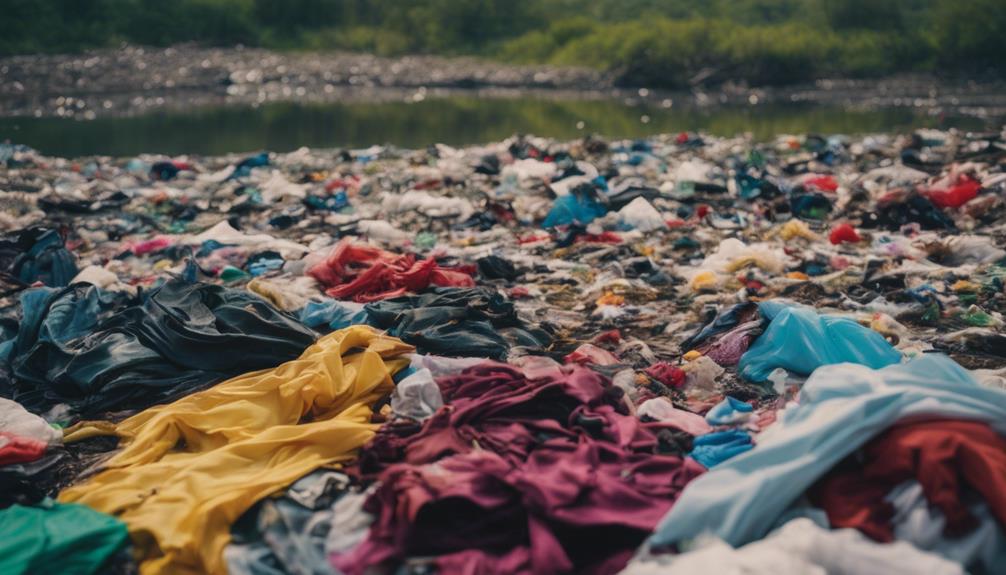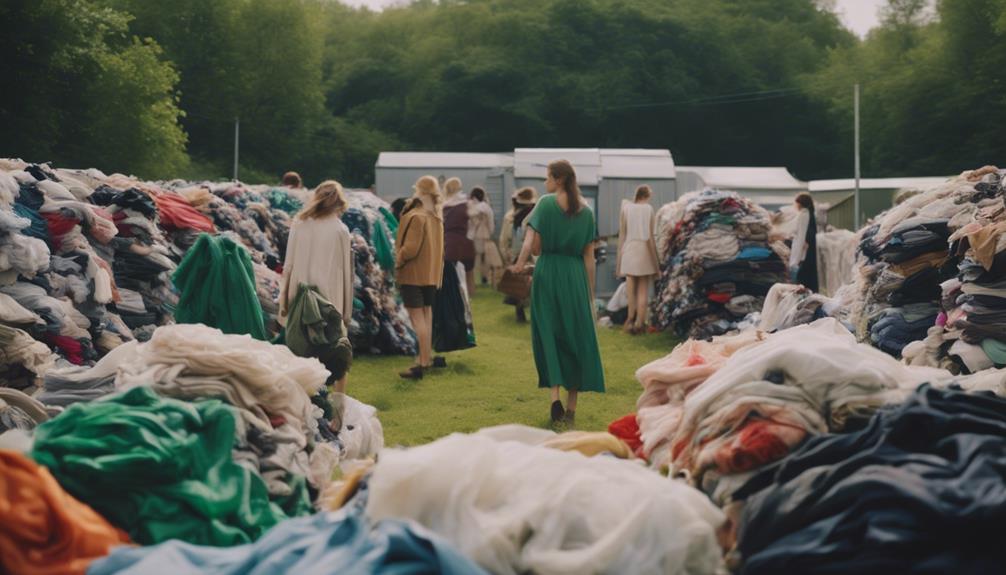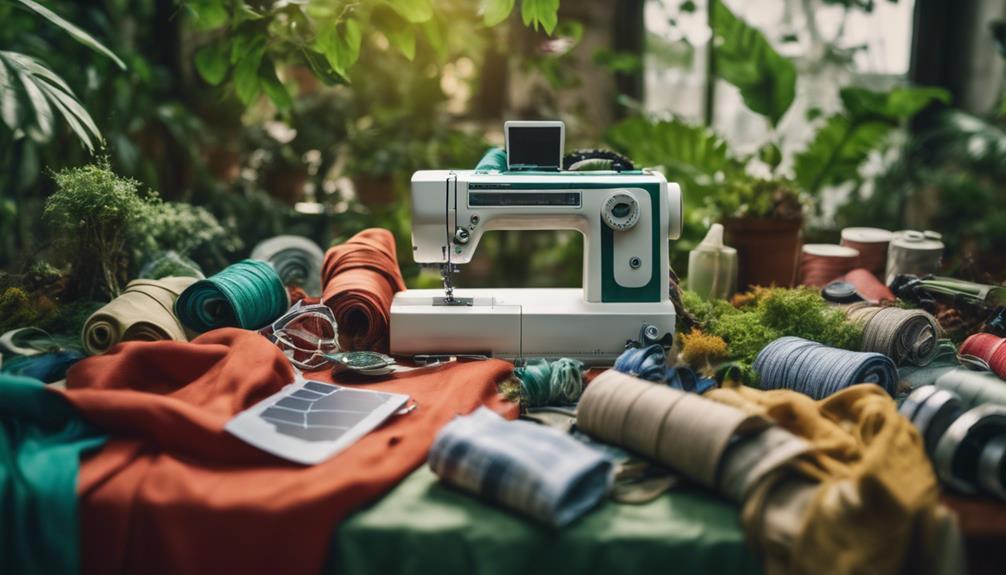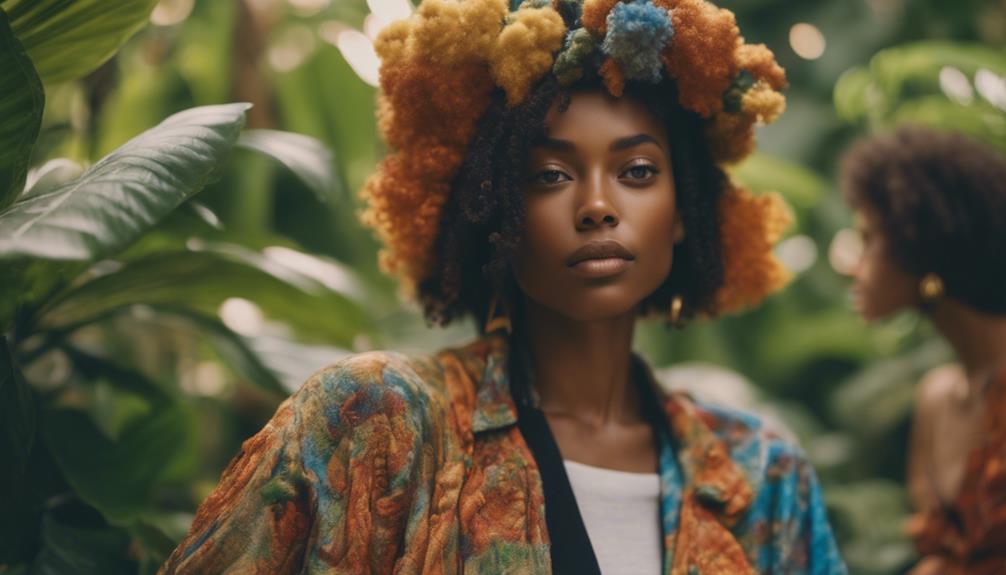Engaging in sustainable fashion practices can have a significant positive impact on the environment, as it helps reduce waste and conserve vital resources. By selecting eco-friendly materials and supporting recycling and upcycling initiatives, you can play a role in decreasing carbon emissions and water pollution. Extending the lifespan of your clothing alone can reduce environmental impact by up to 30%. Participating in community swaps and shopping at thrift stores promotes a circular economy, which in turn helps to minimize contributions to landfills. Choosing to support brands that prioritize sustainability means you are actively contributing to a healthier planet. Not only does this approach benefit the earth, but it also presents opportunities for exploring innovative practices and solutions.
Key Takeaways
- Sustainable fashion reduces carbon emissions and water waste by promoting eco-friendly materials and manufacturing practices.
- Extending the lifespan of garments can decrease environmental impact by 20-30%, minimizing textile waste.
- Recycling and upcycling initiatives transform discarded clothing into new products, reducing landfill contributions.
- Waterless dyeing techniques significantly cut water pollution and energy consumption in the dyeing process.
Environmental Impact of Fashion
The fashion industry's environmental impact is staggering, contributing to considerable carbon emissions and waste that harm our planet. Fast fashion promotes a cycle of overconsumption, leading to nearly 10 million tons of textile waste in U.S. landfills every year. When these items decompose, they release greenhouse gases, further exacerbating global warming. You mightn't realize that the production of one pair of jeans consumes an astonishing 7,500 to 10,000 liters of water, highlighting the industry's immense water consumption.
Sustainable fashion offers a way to combat these issues. By choosing ethical fashion brands that utilize recycled materials, you can help reduce the carbon emissions associated with new textile production. Supporting brands that prioritize sustainability not only decreases textile waste but also encourages more responsible manufacturing practices. When you opt for quality over quantity, you contribute to a shift away from the harmful fast fashion model.
Incorporating sustainable practices into your fashion choices can notably lessen the industry's environmental impact. By making conscious decisions, you can help protect our planet's essential resources and promote a healthier ecosystem for future generations.
Resource Consumption in Fashion

Fashion's massive resource consumption plays a crucial role in its environmental impact, with staggering amounts of water and energy required for production. To put things into perspective, consider how much water is consumed when creating clothing items.
| Clothing Item | Water Consumption (liters) |
|---|---|
| Pair of Jeans | 7,500 – 10,000 |
| Cotton T-Shirt | 2,650 |
| Polyester Fabric | 70 million barrels of oil/year |
| Organic Cotton | 50% less than conventional |
| Extended Lifespan | 20-30% less impact |
The fashion industry is notorious for its drain on water bodies, with around 93 billion metric tons of clean water used each year. By choosing sustainable practices, like opting for organic cotton, you can help reduce the carbon footprint associated with clothing production. Furthermore, extending the lifecycle of your clothing items just nine months can greatly lower their environmental impact. By being mindful of resource consumption in fashion, you're taking important steps toward a more sustainable future.
Fast Fashion Consequences

Fast fashion isn't just about trendy clothes; it's a major player in environmental pollution and resource depletion.
When you buy those cheap, disposable items, you contribute to staggering amounts of textile waste and high carbon emissions.
Understanding the real impact of your fashion choices can help you make more sustainable decisions.
Environmental Pollution Impact
Fast fashion wreaks havoc on our environment, generating immense carbon emissions and pollution that threaten both natural resources and ecosystems. The consequences are staggering: the industry is responsible for 8-10% of global carbon emissions and nearly 20% of global wastewater, contributing greatly to water pollution. If you think about it, every piece of clothing you buy can add to the ever-growing fashion waste crisis.
Here's a breakdown of these alarming statistics:
| Impact | Details |
|---|---|
| Textile Waste | Over 16 million tons generated in the U.S. in 2017 |
| Synthetic Fabrics | Can take up to 200 years to decompose |
| Water Pollution | Dyeing processes contribute to 17-20% of industrial pollution |
When clothing is recycled or made from natural materials, the environmental impacts lessen greatly. However, with synthetic fabrics dominating fast fashion, the cycle of waste and pollution continues. Sustainable products can break this cycle, helping reduce carbon emissions and the toxic burden on our waterways. It's time to rethink your fashion choices for a healthier planet.
Resource Depletion Issues
The relentless demand for cheap clothing is depleting our planet's precious resources at an alarming rate. Fast fashion promotes overconsumption, leading you to buy 60% more clothing than you did in 2000, while discarding a staggering 73% of it. This cycle of overproduction and clothing waste results in significant resource depletion.
For instance, producing just one pair of jeans consumes between 7,500 and 10,000 liters of water, which is a staggering amount for a single item. Moreover, synthetic fabrics, making up 65% of global clothing, rely on around 70 million barrels of oil annually, further contributing to both resource depletion and environmental degradation.
Unfortunately, less than 1% of clothing is recycled into new garments. Instead, a shocking 53 million metric tons of discarded clothing end up incinerated or in landfills every year, exacerbating the depletion of natural resources.
Sustainable fashion provides a solution by prioritizing recycled materials and encouraging responsible consumption. By choosing sustainable options, you can reduce the environmental impact of your wardrobe and help mitigate resource depletion for future generations.
Waste Management Solutions

Innovative waste management solutions are essential for tackling the fashion industry's staggering textile waste problem, as they can considerably reduce the environmental impact of discarded clothing. With the fast fashion trend leading to 92 million tons of textile waste each year, it's clear that we need effective methods to manage this waste.
Here's a quick overview of sustainable waste management solutions:
| Solutions | Impact on Waste Management |
|---|---|
| Recycling Programs | Convert clothing items into new fibers, reducing landfill waste. |
| Upcycling | Transform discarded clothing into new products, extending their lifecycle. |
| Donation Initiatives | Provide clothing to those in need while minimizing waste. |
| Natural Fabric Use | Encourage biodegradable materials that decompose quickly, reducing pollution. |
| Consumer Education | Promote responsible disposal practices and sustainable consumption. |
Innovations in Sustainable Fashion

You're about to discover how innovations in sustainable fashion are reshaping the industry.
From eco-friendly materials to waterless dyeing techniques, these advancements not only reduce waste but also promote a circular fashion economy.
Let's explore how these cutting-edge solutions are making a positive impact on our environment.
Eco-Friendly Material Development
Eco-friendly material development is transforming the fashion industry by introducing biodegradable textiles and sustainable fibers that greatly lower environmental impact. You'll find innovations such as microbial bioleather and Werewool, which decompose much faster than traditional synthetic materials, helping to combat waste.
Companies like Evrnu are pioneering the use of recycled polyester made from discarded clothing, effectively recycling textile waste and minimizing resource consumption. This not only reduces the demand for new materials but also lessens the burden on landfills.
Regenerative cotton is another exciting development, focusing on soil health and biodiversity while greatly reducing water and chemical usage in cotton production.
Moreover, sustainable materials derived from agricultural waste—like pineapple leaves or orange peels—are gaining popularity. These materials allow for innovative fabric creation while addressing food production waste.
Waterless Dyeing Techniques
Frequently overlooked in discussions about sustainable fashion, waterless dyeing techniques are revolutionizing the way fabrics are colored without harming the environment. These innovative methods, like DyeCoo and supercritical CO2 processes, are changing the landscape of textile production. Here's why you should care:
- Reduced Water Pollution: Traditional dyeing methods account for 17-20% of global industrial water pollution, while waterless techniques considerably lower this impact.
- Lower Carbon Footprint: By requiring less energy, waterless dyeing decreases the carbon footprint associated with dyeing fabrics.
- Cost Savings: Manufacturers adopting these technologies can save on water and wastewater treatment expenses, making sustainable practices economically viable.
- Appeal to Eco-Conscious Consumers: Brands using waterless dyeing can attract environmentally-conscious consumers, enhancing their market position.
These advancements not only contribute to cleaner, more responsible textile production but also align with the growing demand for sustainable practices.
When you support brands that prioritize waterless dyeing techniques, you're making a conscious choice to foster a healthier planet. Embrace this change and help shape the future of fashion!
Circular Fashion Economy
Building on the momentum of waterless dyeing techniques, the circular fashion economy is reshaping how we think about the lifecycle of garments and their impact on the environment. This innovative approach focuses on recycling, upcycling, and rental services to extend the lifecycle of clothing, considerably reducing the staggering 92 million tons of textile waste produced annually.
By embracing a closed-loop system, brands can transform discarded clothing into new fibers, as seen with Evrnu's NuCycl technology. This not only minimizes resource extraction but also lowers carbon footprints, making production processes more sustainable. You can contribute to this shift by participating in secondhand sales and rental platforms. This way, you enjoy variety without fueling new production, which helps combat fast fashion.
Moreover, initiatives like the Better Cotton Initiative promote sustainable practices among manufacturers, encouraging the use of organic cotton or recycled materials. As you engage with these sustainable practices, you help foster a circular economy that not only benefits the planet but also sets a new standard for the fashion industry.
Community Engagement and Consumer Action

Community engagement in sustainable fashion inspires individuals to take action, fostering collaboration and awareness while promoting environmentally conscious choices. When you participate in community-driven initiatives, you not only support sustainable practices but also create a ripple effect that influences others.
Here's how you can make a difference:
- Join local clothing swaps – Exchange garments with friends to breathe new life into your wardrobe while reducing waste.
- Shop at thrift stores – By choosing secondhand shopping, you help prevent millions of tons of clothing from reaching landfills.
- Support sustainable brands – Make informed purchases that prioritize ethical production and environmental stewardship.
- Participate in educational workshops – Learn about the environmental impact of your consumer habits and how to make mindful fashion choices.
Your involvement in these activities strengthens community ties and promotes a circular economy, where resources are shared and reused.
The Future of Sustainable Fashion

As consumer demand for eco-friendly solutions grows, the future of sustainable fashion is poised for significant transformation through innovative materials and production methods.
With projections showing clothing waste could soar to 148 million tons by 2030, it's clear that urgent action is needed. Embracing sustainable fashion isn't just a trend; it's a necessity.
The circular economy is becoming a game-changer, pushing brands to adopt recycling models and rental services to minimize waste and enhance garment longevity. These approaches not only reduce clothing waste but also create a more responsible fashion ecosystem.
Technological advancements, like digital fashion and cutting-edge recycling techniques, are paving the way for new standards in sustainability.
You play an essential role in this shift. By supporting brands that prioritize eco-friendly solutions, you can help drive the change toward a more sustainable future.
The collaboration between consumers, brands, and regulators is critical for achieving long-term environmental benefits. As you seek sustainable fashion choices, remember that every purchase contributes to a healthier planet.
Together, we can reshape the industry and guarantee that the future of fashion is both stylish and sustainable.
Frequently Asked Questions
How Does Sustainable Fashion Help the Environment?
Sustainable fashion helps the environment by reducing waste, lowering carbon emissions, and minimizing water usage. You can support eco-friendly practices by choosing biodegradable materials, upcycling, and opting for rental services instead of fast fashion.
What Are the Benefits of Sustainable Fashion?
Sustainable fashion offers you numerous benefits, like reducing waste, lowering carbon emissions, and promoting eco-friendly materials. You'll enjoy unique styles while contributing to a healthier planet and supporting ethical practices within the fashion industry.
How Can We Improve Sustainability in Fashion?
"You reap what you sow." To improve sustainability in fashion, embrace circular practices, choose sustainable materials, and support brands with transparent supply chains. Small choices can make a big difference for our planet's future.
How Is Sustainable Fashion Good?
Sustainable fashion's good because it reduces waste, promotes ethical practices, and encourages mindful consumption. By choosing eco-friendly brands, you're supporting a healthier planet, improving workers' conditions, and making a positive impact on future generations.
What Impact Does Sustainable Fashion Have on the Use of Natural Resources?
Sustainable natural resource usage in fashion can lead to a significant reduction in environmental impact. By using eco-friendly materials and implementing renewable manufacturing processes, sustainable fashion can help conserve water, reduce carbon emissions, and decrease the overall depletion of natural resources.
Conclusion
In a world where fashion often mirrors the fleeting nature of a summer breeze, embracing sustainable practices can transform our environmental landscape.
By choosing eco-friendly materials, supporting ethical brands, and reducing waste, you're not just making a statement; you're joining a movement reminiscent of a modern-day renaissance.
Together, we can weave a future where style and sustainability coexist, proving that fashion can indeed be a force for good.
Let's turn the tide, one conscious choice at a time!








